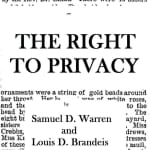“The Right to Privacy” by Warren and Brandeis
By Kristopher A. Nelson
in
December 2011
700 words / 4 min.
Tweet
Share
The modern “right to privacy” is frequently attributed to Warren and Brandeis’ groundbreaking 1890 law review essay of that same name. Its initial purpose, according to Steven Childress, was to recognize, within the traditional common law, “a civil and non-contractual right of protection against invasions of privacy.”

Please note that this post is from 2011. Evaluate with care and in light of later events.
 The modern “right to privacy” is frequently attributed to Warren and Brandeis’ groundbreaking 1890 law review essay of that same name. Its initial purpose, according to Steven Childress, was to recognize, within the traditional common law, “a civil and non-contractual right of protection against invasions of privacy.” Their stated goal was to protect a person’s “inviolate personality” (Warren and Brandeis 195, 215) especially in the face of an increasingly invasive press whose impositions were made possible through new technologies like photography and faster newspaper printing and distribution.
The modern “right to privacy” is frequently attributed to Warren and Brandeis’ groundbreaking 1890 law review essay of that same name. Its initial purpose, according to Steven Childress, was to recognize, within the traditional common law, “a civil and non-contractual right of protection against invasions of privacy.” Their stated goal was to protect a person’s “inviolate personality” (Warren and Brandeis 195, 215) especially in the face of an increasingly invasive press whose impositions were made possible through new technologies like photography and faster newspaper printing and distribution.
In their twenty-eight page piece, Brandeis and Warren chastised the journalists o f their day, particularly photojournalists, for prying into people’s private lives in search oqawdry and alluring “news,” and then made a cogent plea for the law to recognize a right to privacy and to impose liability in tort for these and other types of invasions of privacy. They got what they wanted–and more. (Bratman 624)
Much of their argument focused on limiting the public dissemination of private details of a person’s life, a goal that many find to conflict with First Amendment protections of speech and the press. But Warren and Brandeis saw the right to privacy as articulating an existing principle that had already been applied in many other contexts without constitutional problems: protections of one’s home, prohibitions of the publication of one’s private papers, and prohibitions against slander and libel.
Warren and Brandeis began their article by discussing the well-settled protections afforded by the common law to both people and property. The argued that the law had responded to “social, political, and economic changes” by expanding what it protected, such that the law now protected not just against battery, but the threat of battery (assault), as well as assaults on reputation (slander and libel) and even intangible “products of the mind,” like copyright and goodwill (Bratman 630).
The starting point of their critique of existing protections is the press:
The press is overstepping in every direction the obvious bounds of propriety and of decency. Gossip is no longer the resource of the idle and the vicious, but has become a trade. … To satisfy a prurient taste the details of sexual relations are spread broadcast in the columns of the daily papers. (Warren and Brandeis 196)
Warren and Brandeis proceed to reason that privacy deserves protection through analogy to existing law. Thus, the rights to “intellectual and artistic property” were “instances and applications of a general right to privacy.” In the case of copyright, for example, what is protected is not the quality of the writing or its artistic value: the “existence of the right [does not] depend upon the nature or value of the thought or emotion … [as] the same protection is accorded to a casual letter or an entry in a diary.” Thus, just because a photograph of me does not have artistic value does not mean it should not be protected, since its protection arises from being me, not from the effort invested by the photographer nor from its potential status as an important commentary on life. Even if I send a letter to someone else, they do not have the write to publish it without my consent. The underlying goal is to allow an individual to control the dissemination of what is, fundamentally, theirs. But it is not a property right in the traditional sense, and is not about physical possession or trespass:
The principle which protects personal writings and all other personal productions, not against theft and physical appropriation, but against publication in any form, is in reality not the principle of private property, but that of an inviolate personality (205).
And the invasion of privacy, they continue, is like the “injuries sustained … by an attack upon reputation … or a violation of honor.” In each case the injury is non-physical, but real, and similar injuries are already punishable by law. In short, “existing law affords a principle which may be invoked to protect the privacy of the individual” (206).